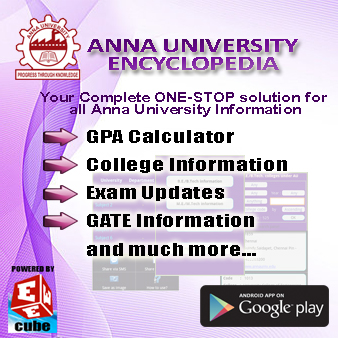SUBJECT RESOURCES:
CLICK HERE to access 'Question Banks'
CLICK HERE to access 'Previous Year Question Papers'
CLICK HERE to search more about this subject
SYLLABUS:
CLICK HERE to access 'Question Banks'
CLICK HERE to access 'Previous Year Question Papers'
CLICK HERE to search more about this subject
SYLLABUS:
|
EE2451
|
ELECTRIC ENERGY GENERATION, UTILISATION
AND
|
L T P C
|
|
|
CONSERVATION
|
3 0 0 3
|
AIM
To expose students to the main aspects of generation, utilization and conservation.
OBJECTIVES
To
impart knowledge on Generation of electrical power
by
conventional
and
non–conventional methods.
Electrical energy conservation, energy auditing and power quality.
Principle and design of illumination systems and methods of heating and welding. Electric traction systems and their performance.
Industrial applications of electric drives.
UNIT I POWER GENERATION 9
Review of conventional methods – thermal, hydro and nuclear based power generation. Non-
conventional methods of power generation – fuel cells - tidal waves – wind – geothermal – solar - bio-mass
-
municipal
waste. Cogeneration.
Effect
of distributed generation
on power system
operation.
UNIT II ECONOMIC ASPECTS OF GENERATION 9
Economic
aspects of power generation – load and load duration curves – number and size of units – cost of electrical
energy – tariff. Economics of power
factor
improvement – power
capacitors – power quality. Importance of electrical energy conservation
– methods – energy efficient equipments.
Introduction to energy auditing.
UNIT III ILLUMINATION 9
Importance of lighting – properties of good lighting scheme – laws of illumination – photometry -
types of
lamps
–
lighting
calculations – basic
design of
illumination schemes for residential,
commercial, street lighting, and sports ground - energy efficiency lamps.
UNIT IV INDUSTRIAL HEATING AND WELDING 9
Role electric heating for industrial applications – resistance heating – induction heating – dielectric heating - electric arc furnaces. Brief introduction to electric welding – welding generator, welding
transformer and the characteristics.
UNIT V ELECTRIC TRACTION 9
Merits of electric traction – requirements of electric traction system – supply systems – mechanics of
train movement – traction motors and control – braking – recent trends in electric traction.
TOTAL : 45 PERIODS
TEXT BOOKS
1. C.L. Wadhwa, ‘Generation, Distribution and Utilization of Electrical Energy’, New Age
International Pvt. Ltd, 2003.
2. B.R. Gupta, ‘Generation of Electrical Energy’, Eurasia Publishing House (P) Ltd, New
Delhi, 2003.
REFERENCES
1. H. Partab, ‘Art and Science of Utilisation of Electrical
Energy’, Dhanpat Rai and Co, New
Delhi, 2004.
2. E. Openshaw Taylor, ‘Utilization of Electrical Energy in SI Units’, Orient Longman Pvt. Ltd,
2003.
3. J.B. Gupta, ‘Utilization of Electric Power and Electric Traction’, S.K. Kataria and Sons,
2002.
|
|










No comments:
Post a Comment
Note: Only a member of this blog may post a comment.